Xylophanes cyrene
Xylophanes cyrene
zail-AH-fan-eesmm
SIGH-ree-nee
(Druce, 1881) Chaerocampa [sic])
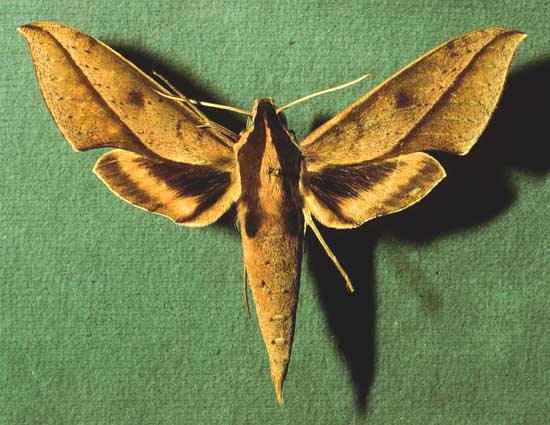
Xylophanes cyrene male courtesy of Dan Janzen.
This site has been created by
Bill Oehlke at
oehlkew@islandtelecom.com
Comments, suggestions and/or additional information are welcomed by
Bill.
TAXONOMY:
Family: Sphingidae, Latreille, 1802
Subfamily: Macroglossinae, Harris, 1839
Tribe: Macroglossini, Harris, 1839
Genus: Xylophanes Hubner [1819] ...........
Species: cyrene (Druce, 1881)
|
MIDI MUSIC
.....It's a Wonderful World.....
copyright C. Odenkirk
ON.OFF
<bgsound src="world.mid" LOOP=FOREVER>
|
DISTRIBUTION:
Xylophanes cyrene
(wingspan: 76-91 mm) flies in
Panama (specimen type locality);
Costa Rica;
Guatemala: Izabal (JM);
Belize: Cayo, Toledo; and
Mexico.
They are also reported as far south as Oxapampa, Peru.
Kitching and Cadiou elevate this moth to full species status in 2000.
Cyrene is decidely brown and flies at lower elevations than
the green, montane staudingeri.
"Very similar to Xylophanes amadis but upperside ground colour brownish, even when fresh.
Similar to Xylophanes amadis but pale median band always uninterrupted by black streaks along the veins." CATE
The specimens on this page with greenish-grey colouration may be Xylophanes amadis.
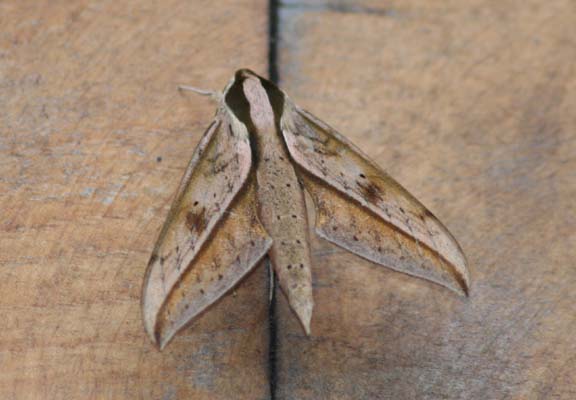
Xylophanes cyrene, Trapp Family Lodge, 1Km from
Monteverde Cloud Forest Preserve,
Costa Rica,
June 6th 2005, courtesy of Mark Dennis via Andy Adcock.
The pronunciation of scientific names is
troublesome for many. The "suggestion" at the top of the page is
merely a suggestion. It is based on commonly
accepted English pronunciation of Greek names and/or some
fairly well accepted "rules" for latinized scientific names.
The suggested pronunciations, on this page and on other pages,
are primarily put forward to assist those who hear with internal
ears as they read.
There are many collectors from different countries whose
intonations and accents would be different.
Jean Marie Cadiou writes, "When I say "Xylophanes" in English I
pronounce it something like "Zailophanees", with the emphasis on the
"o". The French pronounce it differently, something like
"Kzeelophaness" with no emphasis, and the Germans yet in a
different way..."
"Xylophanes" sounds like it is from Greek mythology.
Apollo found Cyrene wrestling alone with a lion and carried her off
to that part of Libya where in later times he founded a city and
named it, after her, Cyrene.
Theretra drucei Kirby, 1892, is the same as
Xylophanes cyrene.
Theretra staudingeri Rothschild, 1894, Panama,
is also elevated to full species status, Xylophanes staudingeri
Kitching and Cadiou 2000.
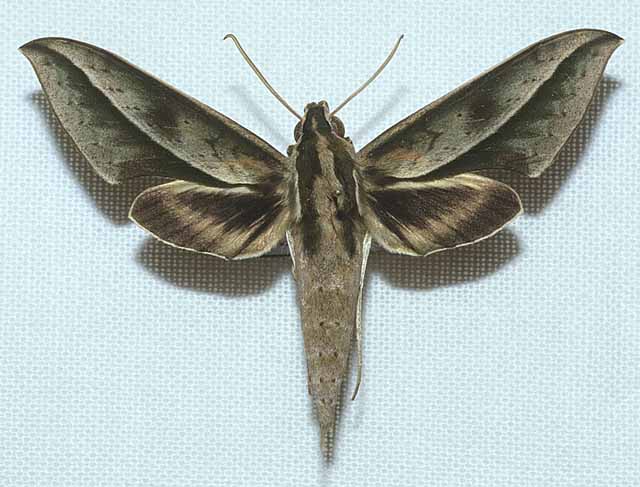
Xylophanes cyrene male (probably amadis), courtesy of Hubert Mayer
copyright.
FLIGHT TIMES:
Xylophanes cyrene adults probably
fly continuously in Costa Rica.
ECLOSION:
Pupae probably wiggle to surface from
subterranean chambers just prior to eclosion.
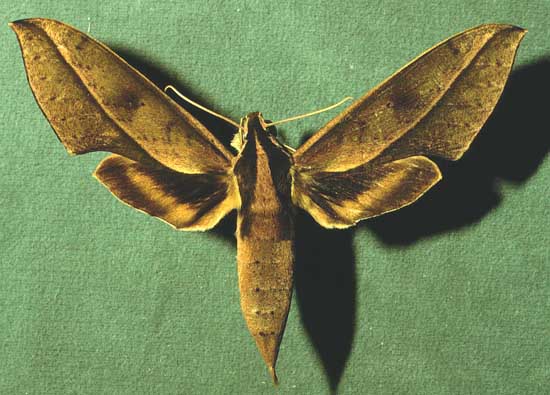
Xylophanes cyrene female courtesy of Dan Janzen.
SCENTING AND MATING:
Females call in the males
with a pheromone released from a gland at the tip of the abdomen.
Males come in to lights very readily, but females are seldom taken
in that way.
Typical resting pose is displayed to the right. Images courtesy
of Dan Janzen. | 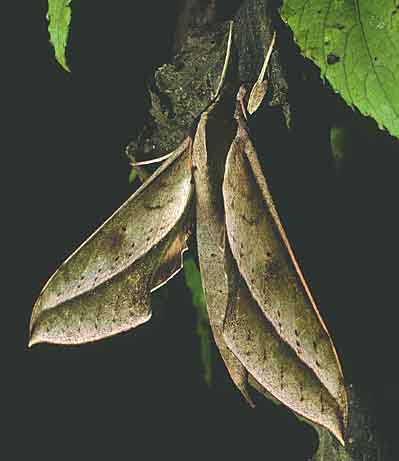
|
EGGS, LARVAE, PUPAE:
Larvae probably feed on Curatella
americana of the Dilleniaceae family and Psychotria
panamensis and Psychotria grandis of the Rubiaceae family.
Early instar larvae are green, but there are green and dark colour
morphs in the final instar.
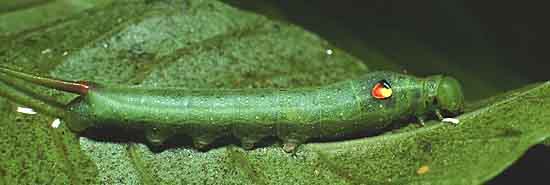
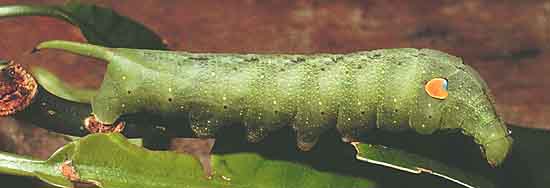

Moths emerge approximately 21-35 days after larvae pupate.
Larvae are susceptible to parasitization by Drino piceiventris
and Drino sp. 6 of the Tachinidae family.
Use your browser "Back" button to return to the previous page.
Goto Main Sphingidae Index
Goto Macroglossini Tribe
Goto Central American Indices
Goto Carribean Islands
Goto South American Indices
Goto U.S.A. tables
Use your browser "Back" button to return to the previous page.
This page is brought to you by
Bill Oehlke and the
WLSS. Pages are on space rented from Bizland. If you would like
to become a "Patron of the Sphingidae Site", contact Bill.
Please send sightings/images to Bill. I will do my best to respond to
requests for identification help.
Enjoy one of nature's wonderments: Live
Saturniidae (Giant Silkmoth) cocoons.
 | 
Show appreciation for this site by clicking on flashing butterfly to the left.
The link will take you to a page with links to many insect sites. |









